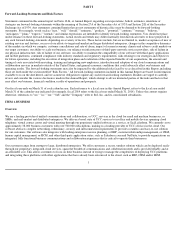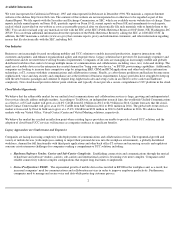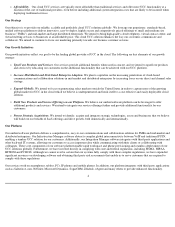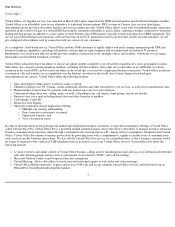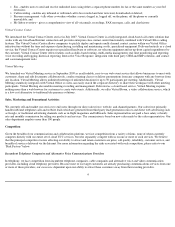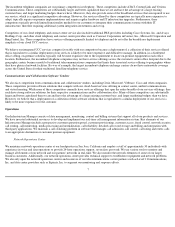8x8 2014 Annual Report Download - page 15
Download and view the complete annual report
Please find page 15 of the 2014 8x8 annual report below. You can navigate through the pages in the report by either clicking on the pages listed below, or by using the keyword search tool below to find specific information within the annual report.
Our success depends on the growth and customer acceptance of our services.
Our future success depends on our ability to significantly increase revenue generated from our cloud communications and collaboration services
to business customers, including SMBs and mid-market and larger distributed enterprises. To increase our revenue, we must add new customers
and encourage existing customers to continue their subscriptions on terms favorable to us, increase their usage of our services, and purchase
additional services from us. For customer demand and adoption of our cloud communications and collaboration services to grow, the quality,
cost and feature benefits of these services must be sufficient to cause customers to adopt them. For example, our cloud telephony and contact
center services must continue to evolve so that high-quality service and features can be consistently provided at competitive prices. As our target
markets mature, or as competitors introduce lower cost and/or differentiated products or services that are perceived to compete with ours, our
ability to sell new customers and obtain renewals from existing customers could be impaired. As a result, we may be unable to extend our
agreements with existing customers or attract new customers or new business from existing customers on terms that would be favorable or
comparable to prior periods, which could have an adverse effect on our revenue and growth.
Historically, our core service offerings have been our cloud telephony and contact center services, which contributed a substantial majority of
our revenues in fiscal years ended March 31, 2014, 2013 and 2012. Marketing and selling new and enhanced features and services, and
additional communications and collaboration offerings, may require increasingly sophisticated and costly sales efforts. Similarly, the rate at
which our customers purchase new or enhanced services depends on a number of factors, including general economic conditions and their
reactions to any price changes related to these additional features and services. If our efforts to upsell to our customers are not successful and
negative reaction occurs, our business may suffer.
To support the successful marketing and sale of our services to new and existing customers, we must continue to offer high-quality education
and customer support. Providing this education and support requires that our customer support personnel have specific technical knowledge and
expertise, making it more difficult and costly for us to hire qualified personnel and to scale up our support operations due to the extensive
training required. The importance of high-quality customer support will increase as we expand our business and pursue new mid-market and
distributed enterprise customers. If we do not help our customers quickly resolve post-deployment issues and provide effective ongoing support,
our ability to sell additional functionality and services to existing customers will suffer and our reputation with existing or potential customers
will be harmed.
Furthermore, we operate in an industry that is subject to significant federal and state regulation in the United States and regulation by various
governments and governmental bodies in other countries in which we offer our communications and collaboration services. Regulations may
impede the growth of our business, impose significant additional costs, and require substantial changes to software and other technology. Also,
new regulations may be adopted that materially reduce demand for our services by businesses.
We face significant risks in our strategy to target mid-market and larger distributed enterprises for sales of our services and, if we do
not manage these efforts effectively, our business and results of operations could be materially and adversely affected.
We currently derive a minority of our revenues from sales of our cloud communications and collaboration services to mid-market and larger
distributed enterprises, but we believe penetrating these customers is key to our future growth. As we target more of our sales efforts to mid-
market and larger distributed enterprises, our sales cycle may become more time-consuming and expensive, we may encounter pricing pressure
and implementation and customization challenges, and revenue recognition may be delayed for some complex transactions, all of which could
harm our business and operating results. In this market segment, the customer's decision to use our service may be an enterprise-wide decision
and, if so, these types of sales would require us to provide greater levels of education regarding the use and benefits of our service, as well as
education regarding privacy and data protection laws and regulations to prospective customers with international operations. As a result of these
factors, these sales opportunities may require us to devote greater sales support and engineering services resources to individual customers,
driving up costs and time required to complete sales and diverting our own sales and engineering resources to a smaller number of larger
transactions, while potentially delaying revenue recognition on transactions for which we must meet technical or implementation requirements.
Furthermore, we may invest significant time and resources with no assurance that a sale will ever be made. We also face challenges building and
training an integrated sales force capable of fully addressing the services and features contained in all of the components in our communications
and collaboration suite, as well as a staff of expert engineering and customer support personnel capable of addressing the full range of
installation and deployment issues that can arise with a comprehensive suite of services like ours. Also, we have only limited experience in
developing and managing sales channels and distribution arrangements for larger businesses. If we fail to effectively execute our strategy to
11


